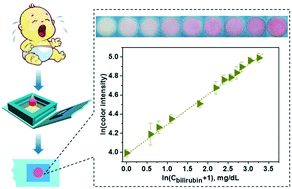Three-dimensional microfluidic tape-paper-based sensing device for blood total bilirubin measurement in jaundiced neonates†
Abstract
More than 60% newborns experience hyperbilirubinemia and jaundice within the initial week after birth due to the accumulation of total bilirubin in blood. Left untreated high levels of bilirubin may result in brain impairment. Simple, fast, accurate, low-cost and timely point-of-care (POC) analysis of total bilirubin is an unmet need especially in resource-limited areas. This work introduces a novel sensing device, named a “tape-paper sensor”, capable of separating plasma from whole blood and measuring total bilirubin by a colorimetric diazotization method. The tape-paper sensing method overcomes non-homogeneous color distribution caused by the “coffee stain” effect, which improves the accuracy of colorimetric evaluation on paper-based analytical devices. The level of hemolysis in the plasma extracted by the device is evaluated, confirming no interference in the detection of total bilirubin. The accuracy of the tape-paper sensing approach for neonatal blood sample measurement is verified by comparison with the hospital pathology laboratory method. The small volume of samples and reagents, minimal equipment (an office scanner), fast detection (<10 min) and low fabrication cost (∼A$ 0.6) reveal the suitability of the device for POC use and in resource-limited settings. The tape-paper sensor is a low-cost, fast, and user-friendly device for measurement of blood total bilirubin levels in neonatal jaundice diagnostics.



 Please wait while we load your content...
Please wait while we load your content...